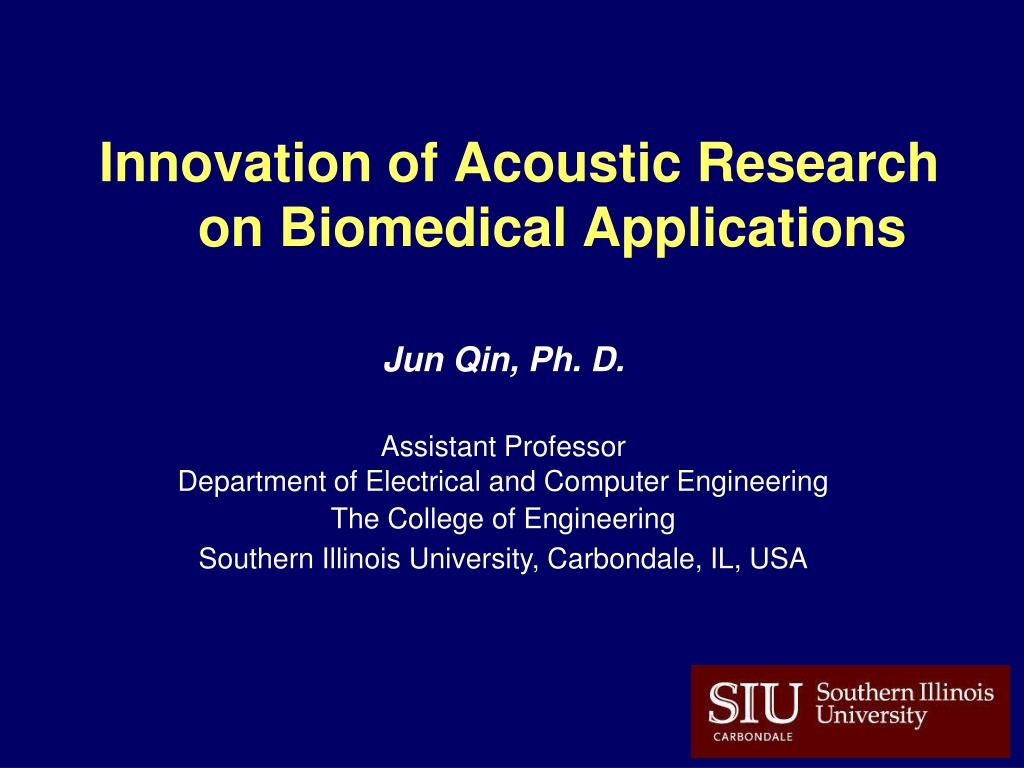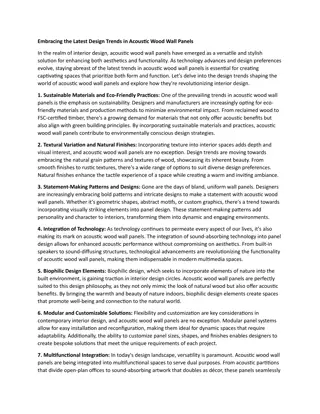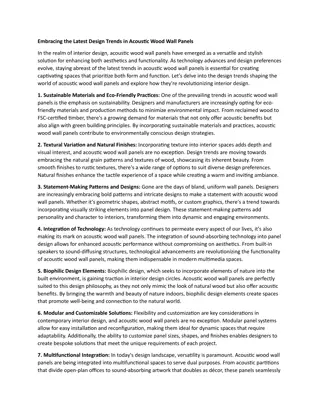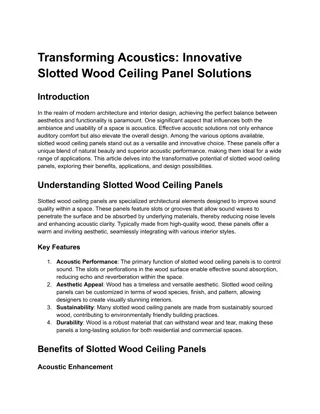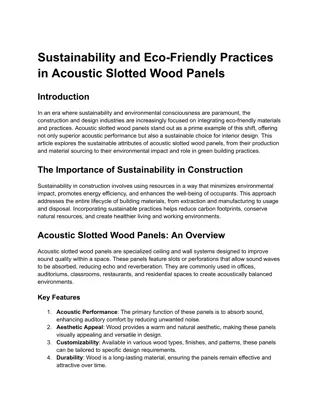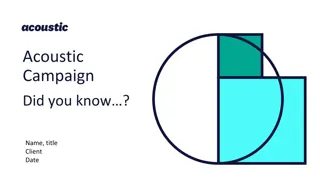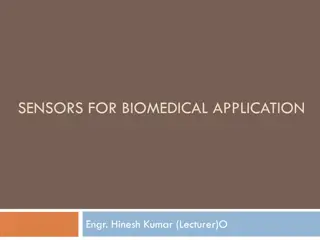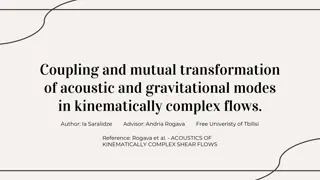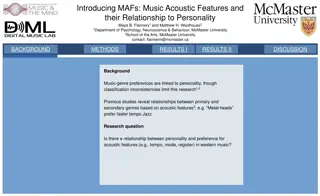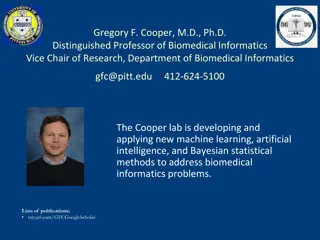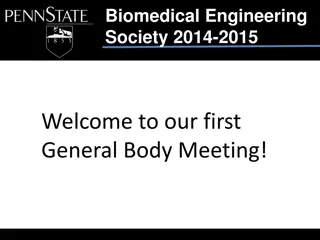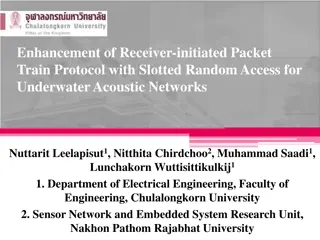Acoustic Research Innovations in Biomedical Applications
Acoustic research in biomedical applications led by Dr. Jun Qin focuses on areas such as therapeutic ultrasound for kidney stone treatment and gene activation, as well as audible sound research on hearing loss and tinnitus. The projects involve comparison of electrohydraulic and electromagnetic shock wave lithotripsy methods, studying acoustic fields, and stone fragmentation. The use of electromagnetic shock wave generators in lithotripters is examined for effectiveness in stone comminution, with a comparison of EH and EM lithotripters. Acoustic field measurement and pressure waveforms are also analyzed for their characteristics in stone fragmentation.
Download Presentation

Please find below an Image/Link to download the presentation.
The content on the website is provided AS IS for your information and personal use only. It may not be sold, licensed, or shared on other websites without obtaining consent from the author.If you encounter any issues during the download, it is possible that the publisher has removed the file from their server.
You are allowed to download the files provided on this website for personal or commercial use, subject to the condition that they are used lawfully. All files are the property of their respective owners.
The content on the website is provided AS IS for your information and personal use only. It may not be sold, licensed, or shared on other websites without obtaining consent from the author.
E N D
Presentation Transcript
Innovation of Acoustic Research on Biomedical Applications Jun Qin, Ph. D. Assistant Professor Department of Electrical and Computer Engineering The College of Engineering Southern Illinois University, Carbondale, IL, USA
Acoustic Research Projects in Our Lab 1. Applications on Therapeutic Ultrasound --- Innovation of Shock Wave lithotripsy (SWL) on Treatment of Kidney Stone Diseases --- Cavitation Bubbles Cell Interaction for Ultrasound Enhanced Gene Activation 2. Applications on Audible Sound --- Research on Noise-Induced Human Hearing Loss --- Diagnosis and Treatment of Human Tinnitus
PART I: Comparison of Electrohydraulic (EH) and Electromagnetic (EM) SWLs Introduction to SWLs. Characterization of acoustic fields Stone fragmentation in vitro and in vivo
Shock Wave lithotripsy P+ Lithotripter shock wave P-
Electromagnetic (EM) Shock Wave Generator Widely use in the newer generation lithotripters Stable and highly reproducible shock waves, long life time High peak pressure and narrow focal beam size Newer generation machines: Less effective in stone 1stgeneration--- comminution Dornier HM-3: Gold standard Higher propensity for tissue injury Newer is not better! Why?
Comparison of EH and EM Lithotripters Electrohydraulic: Unmodified HM-3 at 20 kV Electromagnetic Siemens Modularis at E4.0 In vitro comparison Acoustic fields Stone fragmentation In vivo comparison Stone fragmentation
Acoustic Field Measurement Light Spot Hydrophone (LSHD-2) (Siemens/University of Erlangen-Nuremberg)
Pressure Waveforms at Focus Dual-Peak Structure 1st P+ 1st P+ 2ndP+ P- P- HM3 at 20 kV Modularis at E4.0
Pressure Distribution and Characteristics of Acoustic Fields Peak P+ (MPa) Peak P- (MPa) -6 dB Beam Size, -6dB Beam Size, Head-Foot (mm) Left-Right (mm) Energy (mJ) Effective 48.9 1.3 -10.7 0.6 HM3 at 20 kV 12.5 9.3 42.9 54.3 1.0 -14.4 3.4 Modularis at E4.0 6.8 6.6 62.1
Stone Fragmentation in a Finger Cot Holder Finger Cot Holder 15mm Stone fragments are always kept in a 15 mm diameter area during SWL Do not represent stone fragmentation in vivo
New Stone Holder: Membrane Holder Membrane Holder Finger Cot Holder 30 mm 30 mm 15mm Allow fragments to accumulate & spread out laterally Stone fragments are always kept in a 15 mm diameter area during SWL Do not represent stone fragmentation in vivo Focal Area of HM-3 Mimic more closely stone fragmentation in vivo 2000 shocks in vivo
Spreading of Fragments in a Membrane Holder 0 shocks 50 shocks 100 shocks 250 shocks 1000 shocks 500 shocks Focal Area of HM-3 1500 shocks 2000 shocks
Stone Fragmentation in a Member Holder Membrane Holder 30 mm Allow fragments to accumulate & spread out laterally Mimic more closely stone fragmentation in vivo
Summary of PART I Stone fragmentation produced by the EM lithotripter is lower than that of the EH lithotripter both in vivo and in the membrane holder. The acoustic field characterization demonstrates two distinct differences between EM and EH lithotripters 2nd compressive component in EM pulse, which could reduce maximum bubble size by 50% EM lithotripter has much narrower beam size than EH lithotripter
PART II: Development of a Noise Exposure System for Research on Impulse Noise Induced Hearing Loss Anatomy of Human Ear Noise Induced Hearing Loss Development of the Impulse Noise Exposure System
Noise-Induced Hearing Loss (NIHL) When an individuals hearing is damaged or altered by noise One of the most common occupational disabilities in the United States More than 30,000,000 American workers exposed to unsafe noise levels at their job Estimated 600 million people worldwide exposed to hazardous noise levels
Anatomy of the Human Ear Pinna Tragus Exterior Auditory Canal Tympanic Membrane Ossicles Scala Vestibuli Scala Tympani Cochlea
Anatomical Areas Affected by Different Noise Exposure 1) Gaussian Noise (Steady State Noise): Cochlea and Stria Vascularis 2) Impulse/Impact Noise: Cochlea and Stria Vascularis and possible tympanic membrane and ossicular damage depending on level 3) Kurtosis Noise (complex noise): A combination of Gaussian and impulse/impact noise which can damage all of the above areas depending on the noise content.
Impulse Noise Friedlander sWave (1 t t/t* *) P(t) = Pse t (http://www.arl.army.mil/www/default.cfm?page=352) Ps = peak sound pressure t* = the time at which the pressure crosses the x-axis
Simulated Wave vs. Field-Measured Wave 400 Peak SPL = 158 dB 300 200 1500 100 0 1000 -100 P E SSU R E -200 Pressure R 0 4 6 8 10 10-3 TIME IN SECONDS 500 (Pa) 0 -500 0 1 2 3 4 5 6 Time (ms)
Peak Pressure vs. Output Voltage P(t) SPL = 20log10 dB Pref
Animal Study Verifying the Impulse Noise Induced Hearing Loss Animal Model: Chinchilla 10150daBniSmPaLls were tested Noise Exposure: impulse noise with peak SPL=155 dB at 2 Hz pulse repartition rate for 75 seconds (150 pulses). Auditory brainstem response (ABR) were measured before and 21 days after noise exposure
Animal Study Results 105 dB SPL
Summary of PART II A digital noise exposure system has been developed to generate the impulse noise. The waveforms of impulse noise are comparable to the field measurement test performed by the U.S. Army Impulse noise produces significant hearing loss in animal study. Future work includes Kurtosis noise simulate and high level impulse noise generation.
Upcoming Conference For upcoming conferences please follow the below mentioned link http://www.conferenceseries.com/
